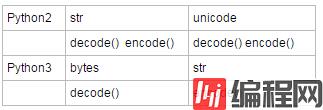今天在写一个Stringio.write(int)示例时思维那么一发散就拐到了字符集的问题上,顺手搜索一发,除了极少数以外,绝大多数中文博客都解释的惨不忍睹,再鉴于被此问题在oracle的字符集体系中蹂躏过,因此在过往笔记的基础上增删了几个示例贴出来。
Python2:
首先清楚两个python 2中的概念:str和unicode 这是Python2中的两种用于表示文本的类型,一般来说你直接打出的字符都属于前者,加了u前缀的字符则属于后者。
str is text representation in bytes, unicode is text representation in characters.
此观点来自stackoverflow,是得票最多的一个回答,也是我认为最好的一个,但是从我个人的角度来看这个表述依然不足,最适合的表述应当是:
str is text representation in bytes, unicode is text representation in unicode characters(or unicode bytes).
貌似没多大区别......可能会被人打,但我的意思是python2里的unicode是字符和编码绑定的,只要是unicode类型那么他的编码和字符都已经固定了,但是str类型却只有编码,只有最初打出它的人才知道他的字符是什么(或者说才能通过适当的字符集解码为人眼可懂的字符)。
Python2里的str是十六进制表示的二进制编码,unicode是一个字符:
通俗点来说就是Python2里的str类型是一堆二进制编码,如果不知道是什么字符集那么你除了一堆十六进制
数什么都看不出来(当然平时你使用的工具都是能看到的,因为工具已经做了转码),通过decode可以将其按固定的字符集解码,生成unicode字符。
例如下例(python2环境下的windows cmd窗口):
>>> a='你好'
>>> a.decode('utf-8')
Traceback (most recent call last):
File "<stdin>", line 1, in <module>
File "C:\Python27\lib\encodings\utf_8.py", line 16, in decode
return codecs.utf_8_decode(input, errors, True)
UnicodeDecodeError: 'utf8' codec can't decode byte 0xc4 in position 0: invalid continuation byte
错误的原因是这里的“你好”字符是cp936编码(相当于gbk),utf-8属于非ANSI体系的编码,“你好”的gbk二进制码不符合unicode体系的编码规则因此报错。
>>> print a.decode('gbk'),type(a.decode('gbk'))
你好 <type 'unicode'>
这样就可以啦,既然a是gbk编码的str那么按gbk进行decode解码,自然能得到unicode的你好字符。decode: str to unicode,decode的输入必须是str类型,输出一定是unicode类型
str.decode(encoding='UTF-8',errors='strict')
encode: unicode to str,encode的输入必须是unicode类型,输出一定是str类型
unicode_char.encode(encoding='gbk',errors='strict')Python3:
在python3中str调用decode()方法会遇到: AttributeError: 'str' object has no attribute 'decode' .
why?
这是因为python3中表示文本的只有一种类型了,那就是str,你以为这是python2里的那个str吗?No! 这个str是python2中的unicode类型......
那么原来的str哪里去了?被命名为bytes类型了,decode方法也随之给了bytes类型,encode给了str类型。

这样做的好处是:
在Python2中str和unicode都有decode,encode两种方法,但是字符集参数不设置正确的话,函数经常报错,文本能否正确流通取决于大家是否清楚输入编码的字符集,这对于全球化的网站来说是个巨坑,而在Python3中无论你输入什么字符,统一都是str类型的(也就是python2里的unicode类型),通过bytes和str类型的分离将decode,encode这两种方法分离,encode函数不会出错,因为编码与字符集是绑定的,你可以随意将unicode字符转化为任意ANSI体系字符集的bytes类型,此时在已知ANSI字符集的情况下,你对bytes类型的decode转码一定不会出错。通过这种方式就避免了python2中输入str类型带来的编码混乱问题。
[root@python ~]# python3
Python 3.6.5 (default, Apr 9 2018, 17:15:34)
[GCC 4.4.7 20120313 (Red Hat 4.4.7-4)] on linux
Type "help", "copyright", "credits" or "license" for more infORMation.
>>> a='你好'
>>> type(a)
<class 'str'>
>>> a.encode('gbk')
b'\xc4\xe3\xba\xc3'
>>> type(a.encode('gbk'))
<class 'bytes'>
通过encode方式我们可以把unicode字符转为任意字符集的bytes类型,这种bytes类型可以通过decode()来重新转为unicode。使用相似的观点来表述Python3中的bytes和str的区别就是:
bytes is text representation in bytes only if you know the charset, str is text representation in unicode characters(or unicode bytes).





0